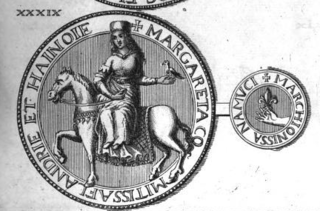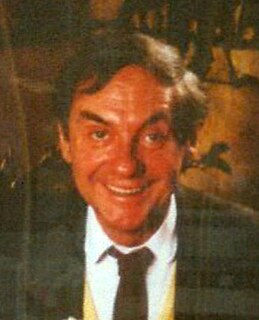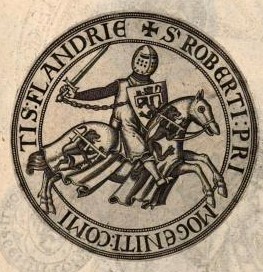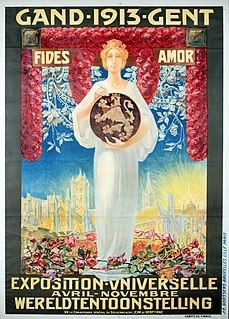
Albrecht Dürer, sometimes spelled in English as Durer or Duerer, was a German painter, printmaker, and theorist of the German Renaissance. Born in Nuremberg, Dürer established his reputation and influence across Europe in his twenties due to his high-quality woodcut prints. He was in contact with the major Italian artists of his time, including Raphael, Giovanni Bellini, and Leonardo da Vinci, and from 1512 was patronized by Emperor Maximilian I.

Ghent is a city and a municipality in the Flemish Region of Belgium. It is the capital and largest city of the East Flanders province, and the third largest in the country, exceeded in size only by Brussels and Antwerp. It is a port and university city.

Margaret I was the countess of Flanders suo jure from 1191 to her death.

Judith Holfelder-Roy, known by her stage name Judith Holofernes, is a German singer, guitarist, songwriter and author.

"Die Gedanken sind frei" is a German song about freedom of thought. The original lyricist and the composer are unknown, though the most popular version was rendered by Hoffmann von Fallersleben in 1842.

Harald Juhnke, was a German actor, comedian, and singer.

Robert III, also called Robert of Béthune and nicknamed The Lion of Flanders, was the Count of Nevers from 1273 and Count of Flanders from 1305 until his death.

Johannes Mario Simmel, also known as J. M. Simmel, was an Austrian writer.

The Battle of Beverhoutsveld took place on 3 May 1382, on a field situated between the towns of Beernem, Oostkamp and Assebroek. It marked an important phase in the rebellion of Ghent against Louis II, Count of Flanders.

Das Käthchen von Heilbronn oder Die Feuerprobe (1807–1808) is a "great historical knightly play" in five acts by the German playwright Heinrich von Kleist. The action of the drama takes place in Swabia during the Middle Ages.

The 1913 International Exposition was a World's Fair held in Ghent from 26 April to 3 November.

Portrait Diptych of Dürer's Parents is the collective name for two late-15th century portrait panels by the German painter and printmaker Albrecht Dürer. They show the artist's parents, Barbara Holper and Albrecht Dürer the Elder, when she was around 39 and he was 63 years. The portraits are unflinching records of the physical and emotional effects of ageing. The Dürer family was close, and Dürer may have intended the panels either to display his skill to his parents or as keepsakes while he travelled soon after as a journeyman painter.

Portrait of Dürer's Father at 70 is a 1497 oil on lime painting attributed to the German painter and printmaker Albrecht Dürer, now in the National Gallery, London. Along with the 1490 Albrecht Dürer the Elder with a Rosary, it is the second of two portraits of the artist's Hungarian father Albrecht Dürer the Elder (1427–1502). The sitter's similarity to the earlier portrait, as well to a 1486 silverpoint drawing believed to be a self-portrait by his father, leave no doubt as to his identity. The London panel is thought to be one of a number of copies of a lost original. It is in poor condition, having suffered paint loss in the background and in areas of the cloak. It was cleaned in 1955, revealing especial quality in the description of the face, leading some to believe that it is a Dürer original. However this claim is not made by the National Gallery who display it as "attributed to Albrecht Dürer".

Lotte Brand Philip was a German art historian, professor and expert on Netherlandish art, one of the most notable and incisive experts on 14th- and 15th-century art to have studied under Erwin Panofsky. Born a Christian of Jewish descent, she resisted state intimidation to leave Germany, only moving to the United States in 1941. She began her new life as a jewelry designer, before establishing a career as an art historian and writer, and taking professorship at a number of universities, including New York University and Queens College, Flushing. During her long career, Brand wrote highly regarded books and monographs on artists such as Jan van Eyck, Albrecht Dürer and Hieronymus Bosch, and in 1980 became emeritus at Queens. Brand Philip died on May 2, 1986 in New York City.

Leyer und Schwert is a patriotic opera in five acts composed by Wendelin Weißheimer to a libretto by Louise Otto-Peters. Also known as Theodor Körner, the opera was composed in 1863/64 and premiered in Munich in 1872. The libretto is based on an episode in the life of the German poet and soldier Theodor Körner.

The Jüngeres Hildebrandslied or Das Lied von dem alten Hildebrand is an anonymous Early New High German heroic ballad, first attested in the fifteenth century. A late attestation of Germanic heroic legend, the ballad features the same basic story as the much older Hildebrandslied, but was composed without knowledge of that text. Rather, it reworks the oral legend of the warrior Hildebrand and his fight against his son in accordance with late medieval and early modern taste. It is highly sentimentalized and focuses on Hildebrand's return home rather than the tragic conflict of the older tradition.

Alte Brücke is a bridge in Frankfurt, Hesse, Germany. It is the oldest bridge over the lower course of the river Main, and until 1886 was the only stone bridge crossing the river. From the Middle Ages until the year 1914, it connected the "Fahrgasse" in Frankfurt Altstadt with the "Brückenstraße" in Sachsenhausen. Since its first mention in official documents in 1222, the development of Frankfurt has been strongly influenced by the bridge. Over the centuries, Alte Brücke has been destroyed and reconstructed at least 18 times. With its 13 brick-built circular arches, the Sachsenhausen Bridge was one of the most prominent buildings of the city, but failing to meet the increasing demands of the modern road and ship traffic, it was demolished in 1914.

Théophile Marie Francois Lybaert or Theofiel Lybaert was a Belgian painter and sculptor. He commenced his career as a painter of genre and Orientalist scenes. He later painted subjects from the national and international history, military life and the bible. He was mainly known for his religious paintings executed in an archaic, Gothic style that reprised the 16th century models of Northern-European masters such as Hans Memling and Albrecht Dürer. These works earned him the appelation of 'modern Gothic' or 'contemporary Memling'. In a final period starting from the 1910s he developed towards an eclectic style incorporating Symbolism.
Anna Strasser was an Austrian resistance activist who helped forced labor and concentration camp victims until her arrest in 1944. She emerged from her internment in successive concentration camps and prisons, followed by time in a labour camp, with her health badly damaged. Over time she was helped to recovery by a doctor who, like her, was a surviving resistance activist.

Konrad Georg (1914–1987) was a German film, stage and television actor. A veteran performer he appeared in numerous films and television programmes in West Germany. Between 1963 and 1966 he played the title role in the television crime series Kommissar Freytag.




















